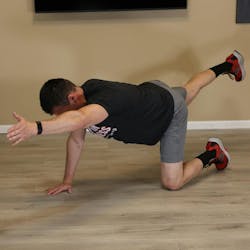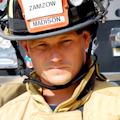Being a firefighter requires more than just physical strength and stamina. It demands a commitment to lifelong fitness that evolves and adapts as you progress through your career. As the challenges of the job take their toll on your body, staying fit becomes not just a necessity but a vital aspect of your ability to perform effectively.
The backbone of success
Functional training is more than just a buzzword. It’s necessary for firefighters. The Mayo Clinic defines functional training as training for the body for the activities that are performed in daily life. This perfectly encapsulates the essence of what first responders must focus on. For firefighters, this includes heavy lifting, dragging equipment, climbing stairs while wearing heavy gear and working on a physically demanding playing field. Therefore, to be effective, any fitness program must be functional and enhance your ability to perform these tasks efficiently.
New recruits
For those who are new to the fire service, transitioning from traditional workouts to functional training to prepare for one’s fire service journey is crucial. Although conventional exercises, such as bench presses and squats, build strength, it’s essential to incorporate fireground-related movements, such as crawling, stair climbing and intervals. Full-body strength and cardiovascular fitness are the cornerstones of a successful career in firefighting.
Starting your fitness journey early, staying consistent, and preparing adequately for physical aptitude tests and academies are critical to ensuring a smooth transition into the fire service.
Active firefighters
Certainly, most seasoned firefighters understand the demands of the job. Consistent workouts that focus on mobility, core strength and cardiovascular fitness are paramount for maintaining peak physical fitness and performing effectively on the fireground.
Including fireground movements and intervals in your routine ensures that you always are ready to tackle the challenges that come your way. Additional emphasis must be placed on weight management, as the stress of the job and shifts accumulate and as pounds are added.
Moving away from heavy lifting and incorporating circuit training, mobility exercises and even yoga can assist experienced firefighters in performance improvement and in preventing injuries as their career progresses.
Chiefs & off-the-front-line officers
Leadership roles in the fire service often mean spending more time behind a desk, which can lead to inactivity and potential health issues. To maintain overall health and fitness, chiefs and off-the-front-line officers must prioritize staying fit and mobile. This can be accomplished through regular, efficient workouts that focus on mobility, metabolism and stress management. Although the intensity of the workouts of these members may differ from front-line firefighters, consistency is all-important to ensuring well-being.
Comprehensive workout plan
As firefighters, no matter where you stand in your fire service journey, you must integrate specific fitness elements to stay in top shape and to excel in your roles. These components are the fire service’s standard operating procedures for a comprehensive workout program that promotes enhancing performance, preventing injuries and ensuring career longevity, so you can keep serving your community at your best.
A structured and comprehensive workout plan is of utmost importance for firefighters at every stage of their career. Training should progress gradually, to build a solid fitness foundation, before moving to more intense strength and power training. Avoiding overly intense workout-of-the-day programs is key to prevent muscle imbalances and injuries. The primary focus should be developing functional strength, improving performance and ensuring long-term career sustainability.
Not having a plan is one of firefighters’ biggest workout mistakes. A lack of a plan leads to injury, fitness burnout and stagnant workouts. A well-structured plan, such as a 4–6-week workout program, can help you to cycle between different goals and to adapt to your weekly schedule.
Remember, as Benjamin Franklin said, “If you fail to plan, you are planning to fail.”
Core strength and balance
Back injuries are a common concern among firefighters. Statistics indicate that 50 percent of firefighters will experience a back injury during their career. Developing strong core muscles, including the glutes, shoulder girdle, hamstrings, hips and core, is pivotal for preventing back injuries and maintaining overall stability. Workouts and programming must focus on planks, glute bridges and balance work to build a strong core and reduce the risk of injuries—in other words, the foundation of fitness.
Cardiovascular conditioning
Effective cardiovascular conditioning must be a cornerstone of your fitness programming. It plays a pivotal role in building the endurance and strength that are necessary for the demanding physical tasks that you face. Although running and biking and similar activities offer benefits, it’s vital to incorporate various aerobic and anaerobic exercises for a well-rounded approach.
Interval training, in particular, mirrors the challenges that members encounter in firefighting scenarios. It enables you to perform at your peak when it matters most.
As you prioritize fitness, it’s necessary to include structured cardiovascular conditioning that progresses from establishing a foundational level to increasing intensity over a set timeline. By focusing on this indispensable component, you can ensure that you always are prepared to effectively meet the physical demands of your roles.
Full-body strength training
As a firefighter, you must engage in functional strength training that targets multiple muscle groups to enhance mobility and prevent injuries. With the diverse movements that you encounter on the fireground, taking a holistic, full-body approach to strength training is needed.
Although body part training has its place, prioritizing full-body workouts can be more efficient and effective. Since you don’t isolate muscles during emergencies, focusing on functional movements that mimic real-life scenarios is significant. Incorporate exercises that utilize dumbbells and various stances, such as pushups, squats and deadlifts, to strengthen muscles and stabilize joints for optimal performance.
Mobility exercises
Maintaining optimal movement efficiency contributes greatly to peak performance on the fireground. Neglecting warmups and stretches during workouts and shifts can increase the risk of injuries and hinder your effectiveness on the job. Integrating mobility exercises into your routine can enhance your range of motion, flexibility and overall movement efficiency. Prioritizing active warmups, dynamic stretches and foam rolling is central to in improving performance and preventing injuries.
Mobility training is arguably the highest priority component of your fitness programming. The way that you move directly affects how you feel and perform. Incorporate a couple of active stretches before your next shift and notice the difference in how your body responds. Consistency is key; don’t overlook this aspect of training.
Recovery days
The demanding nature of firefighting can take a mental and physical toll. Regular recovery days and low-intensity workouts between high-intensity sessions are of great consequence to maintaining a healthy balance and essential for mental and physical well-being. Yoga, walking and swimming can reduce stress, promote relaxation, and recharge body and mind, to ensure that you’re ready to tackle the job challenges.
Finding the right balance in your workout routine and work schedule is required for sustaining a long and fulfilling career in the fire service. Prioritizing fitness, improving performance and preventing injury are mandatory for ensuring that you remain strong, resilient and prepared for any situation. Your commitment to fitness is an investment in your future as a firefighter, allowing you to excel in your current roles and enjoy a long, healthy career serving your crew and community.
Face any challenge
The importance of fitness in a fire service career can’t be overstated. From recruits to seasoned officers, maintaining peak physical condition is obligatory for performing effectively on the fireground and staying healthy throughout their career.
By incorporating functional training and focusing on core strength, cardiovascular conditioning, full-body strength training, mobility exercises and recovery strategies, you can ensure that you’re ready to face any challenge. Your commitment to fitness isn’t just about the present moment but about building a strong and resilient foundation for a long and successful career.
About the Author
Aaron Zamzow
Aaron Zamzow is a firefighter/training officer for Madison, WI, Fire Department. He holds a bachelor’s degree in health/wellness and has 20 years of experience as a fitness trainer. He created Fire Rescue Fitness and authors programs that are aimed at getting fire rescue athletes fit for duty.


